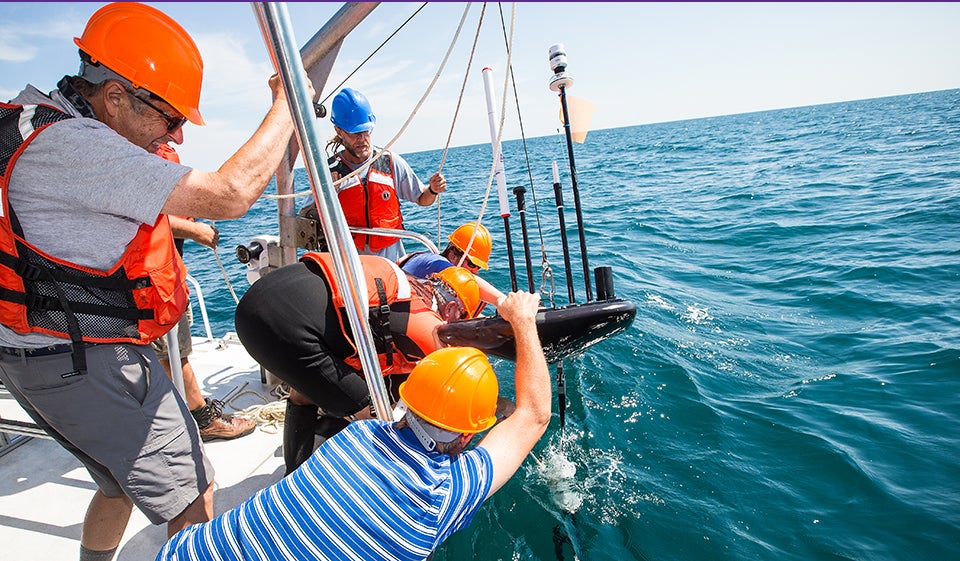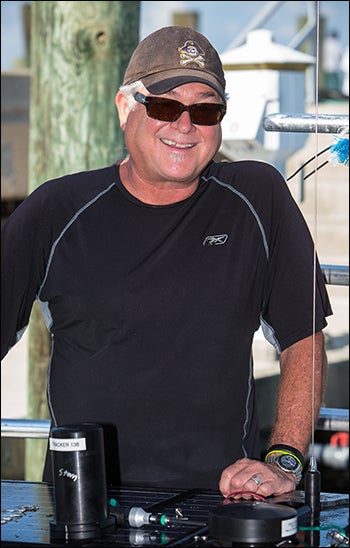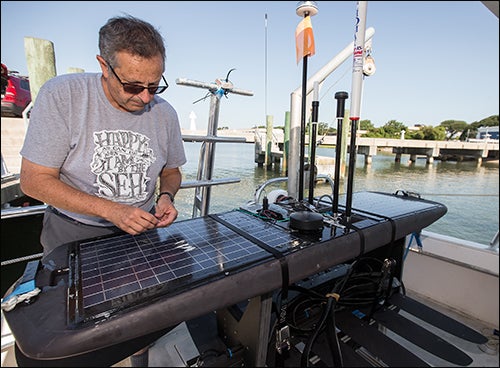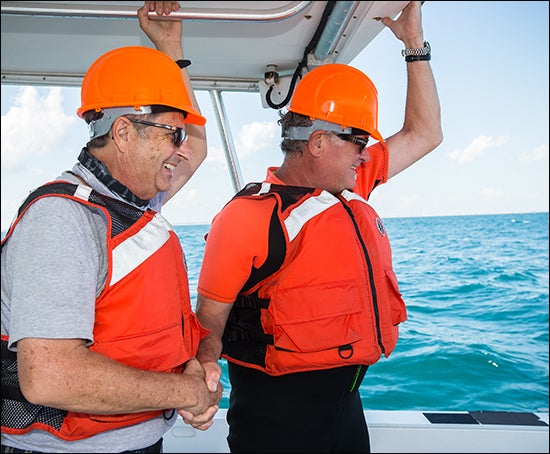SCIENCE ON THE SEA
ECU craft listens and records vital ocean data
East Carolina University scientists have been sending a small craft to navigate the North Carolina coast studying underwater noise and keeping tabs on tagged marine life all to better understand the ocean environment.
Called an acoustic wave glider, the metal-and-composite device is an ocean-going robot that studies underwater noise; acoustically tagged fish such as tuna, flounder and sharks; whales, plankton and ocean environmental conditions. The device is manufactured by Liquid Robotics and was funded by a $281,393 grant from the National Science Foundation. ECU researchers have nicknamed the craft “Blackbeard.”
ECU is among a handful of universities that have a wave glider and the only UNC-system school with one. Joseph Luczkovich, a biology professor and specialist in the sounds fish make, said the device will provide a significant step forward in ECU’s coastal research capabilities.
Cruising along the surface, it’s about the size of an ironing board. ECU researchers launched and tested it in August near the Queen Anne’s Revenge shipwreck near Morehead City and Beaufort and deployed again this month in the same area. Part of its initial work has been surveying an artificial reef established by the N.C. Division of Marine Fisheries. Historically important feeding grounds for endangered species of right whales are in the area off Shackleford Banks, and ECU researchers hope to document the songs of northern right whales as they migrate past the coast, along with other fishes such as red drum, spotted seatrout and weakfish.
“It is a fully instrumented oceanographic platform for studying the acoustic environment off North Carolina,” Luczkovich said. “There are less than 400 individuals of the northern right whales left on Earth, and most of them pass by our coast on their migration from the Arctic off Greenland to the tropics.”
It also will provide valuable data on the potential effects of oil and gas exploration and wind turbine development in coastal waters.
“We expect the wave glider will jump-start our coastal acoustic research in this area,” said Luczkovich. “Oil and gas development, as well as wind energy turbines, have been proposed along our coast. Seismic surveys to locate deposits of oil and gas are likely to begin soon.”
These ocean energy projects must be conducted and sited in ways that avoid or minimize impacts to the whales and fish such as Atlantic sturgeon, an endangered species of ancient fish, he said.“Many of these fishes are tagged acoustically, so we can detect their movements with the wave glider as well,” he said. Acoustic tags are small, surgically implanted sound-emitting devices that allow the detection and/or remote tracking of fish for fisheries research.
The wave glider can act as a stationary platform or be propelled to specific points using GPS technology. A submarine unit with wings or fins generates forward motion by wave action. Two solar panels provide energy for sensors.
Pictured above, ECU biology professor Roger Rulifson works on the wave glider before it is launched. Below, Rulifson and biology professor Joseph Luczkovich shake hands before the wave glider is brought back on board the R/V Cutting Edge. The researchers launched and tested the glider in August near Morehead City and Beaufort.
ECU expects to receive funding to support these wave glider surveys from the NSF, the Bureau of Ocean Energy Management, the Office of Naval Research and the National Oceanic and Atmospheric Administration to study the impacts on whales and fishes and their food supply. These agencies will use the data to minimize impacts to the ecosystem, while allowing some energy extraction in areas away from critical habitats.
ECU’s model has a unique suite of sensors including a system for listening to and recording ocean soundscapes, sound-producing fishes and whales; an acoustic tag-detection system for finding tagged animals such as many fish species and sharks; and a fluorometer for measuring ocean color and plankton.
It also has a conductivity, temperature and depth sensor with oxygen-measurement capabilities. On the surface float are instruments for monitoring waves, currents and surface meteorology.
“It will send us alerts when right whales and other fishes are detected,” Luczkovich said. “So far, we have detected bottlenose dolphins and striped cusk eels (a sound-producing fish) in our first deployments. We are still analyzing the data; there was an acoustic algorithm match for right whale sounds, but that match has to be confirmed with our team after some additional work.”
His team has about 23 hours of sound files to analyze. Those files include red drum sounds as well as the sounds of an unidentified species that makes a quacking sound. The data also include temperature, salinity, ocean currents, turbidity and phytoplankton abundance.
Blackbeard is operated over an Internet connection via a satellite link and reports regularly on its location and sends data to shore. It can be at sea for one-month long missions.
ECU researchers are collaborating with scientists at Duke Marine Lab in Beaufort and at St. Andrews University in Scotland. Scientists from the NOAA, N.C. State University, the University of North Carolina at Wilmington and the UNC Institute of Marine Science are also being kept abreast of the work the wave glider is doing.The wave glider will be deployed until the whales have passed by the coast, Luczkovich said. ECU will then report findings at the Coastal Estuarine Research Federation meeting in Portland, Oregon, in November, and to the NSF.

ECU physics professor Mark Sprague and Joseph Luczkovich read and enter data transmitted from the wave glider.
“In addition, we are alerting the U.S. Coast Guard about the general location of these proposed wave glider deployments so they can produce a local notice to mariners,” Luczkovich said. Boaters and commercial fishermen are urged to leave the wave glider alone. The device has warning labels on it, and people have been pulled overboard trying to grab the wave glider from a boat.
The device was built specifically for ECU. The team of ECU scientists working with it, in addition to Luczkovich, are Roger Rulifson of Department of Biology, Mark Sprague of Department of Physics and J.P. Walsh of the Department of Geological Sciences. Ramone Lopez-Rosado of the Institute for Coastal Science and Policy and Eric Diaddorio, Ryan Bradley and Mark Keusenkothen of the Office of Diving and Water Safety were involved in assembling and launching the unit. Coastal resources management doctoral students Cecilia Krahforst, Chuck Bangley and Tyler Peacock worked with the wave glider during the field testing.
The public may follow the wave glider’s deployments and key findings at its Facebook group “Blackbeard Sails the Seas for Science.”
Pictured below, the wave glider is pulled back on board following a successful test launch.


